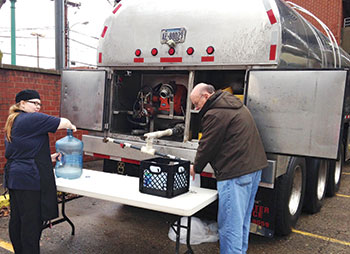
Staff filled one- and five-gallon containers from a water tanker parked outside Charleston (W.Va.) Area Medical Center Health System’s General Hospital during a water emergency last year.
The loss of clean, plentiful water can have a huge impact on hospitals and other health care facilities.
Beyond the hazards of losing water for clinical needs and operational functions such as instrument sterilization, food preparation and environmental services (ES), a loss of water also could damage or render inoperable crucial medical and infrastructure equipment.
Fortunately, industry leaders already have participated in broad-based planning exercises to help health facilities professionals expand their own emergency water supply plans (EWSPs).
Comprehensive approach
One recent analysis identified 15 different potential causes of water disruption, and hospital facility directors and emergency managers have a broad swath of scenarios to consider.
While it sounds counterintuitive, for instance, wastewater disruption often will result in incoming water disruption as well. If the community sewer system fails in the vicinity of a hospital due to a power outage, the community likely will request that large water users stop discharging water. This can result in water disruption if a hospital does not have sufficient wastewater storage capabilities.
An extra issue that often comes into play with water disruptions is cascading failures. For instance, water failures also can result in electrical blackouts, such as when a water main break floods electrical distribution equipment.
A simplistic plan for water disruption may merely mention that tap water and ice are unsafe for consumption. This will suggest acquiring bottled water, placing “do not drink” signs on drinking fountains and the like. However, a more comprehensive approach will consider the broader impact of more than just the loss of drinking water.
Water has many more uses in a hospital that must be considered when planning for a shortage, including hand washing and hygiene, food service, laundry, central services, cleaning and infection prevention, and decontamination and hazardous materials response as well as patient care needs like bathing and flushing toilets. Infrastructure and medical equipment dependent on water include radiology, fire-protection sprinkler systems, water-cooled medical gas and suction compressors and HVAC systems, among others. Extra temporary backup water supplies also may be needed for rinsing contaminated devices, dialysis, labor and delivery, emergency departments (EDs), critical care units and for eyewashing functions.
Water supply planning
The 2012 Centers for Disease Control and Prevention (CDC) “Emergency Water Supply Planning Guide for Hospitals and Health Care Facilities” is an excellent reference for water shortages.
The guide recommends that a typical EWSP team consist of internal representation from facilities management; administration or management; environmental compliance, health and safety; infection control and prevention; risk management; nursing; medical services; emergency management; and security. Recommended external partners include local public water departments, state drinking water agencies, local public health departments, local fire departments and the local department responsible for water reclamation and purification.
At a minimum, EWSP preparation should include assembling the team and background documents, understanding the issues of water use, analyzing emergency supply alternatives, developing the facility’s plan and then regularly exercising the plan. The minimum recommended elements of a comprehensive plan include a facility description, water supply, water demand, pertinent facility drawings, equipment and materials lists, a backflow prevention plan, a description of the maintenance plan (including valve exercising) and copies of all contracts and memoranda of understanding.
It also should include lists of EWSP alternatives, operational protocols such as water treatment and testing, implementation timelines, the plan for recovery, a plan for post-incident surveillance and processes for evaluating and improving the plan.
Managing backup water
While some hospitals have installed underground wells or on-site water storage tanks to provide a backup source of water, many hospitals plan to acquire replacement water from bottled water suppliers. If so, procedures should specify how much prior notice is needed to obtain the required quantities.
Replacement water delivered via water pumper trucks or tankers will require external connections to the campus internal water system. The external connections should be near accessible locations where a diesel truck engine can run 24/7 without impacting indoor air quality.
A hospital should have a clear understanding of both the initial demand and the reduced emergency demand for potable water and non-potable water. For instance, a peer-reviewed paper by the American Water Works Association questions the usefulness of tanker trucks as the only source of emergency water depending upon the water needs of a hospital, citing both over-the-road tanker truck size limitations and the possibility that numerous hospitals in the same localities may rely on the same emergency source.
According to the EWSP guide, short-term alternatives of less than eight hours often include bottled water for drinking, five- and 10-gallon containers for food preparation and hand washing, barrels for flushing toilets and backup plans for potable and non-potable needs.
The recommended alternatives for more than eight hours include all of the short-term measures along with storage tanks and identification of other nearby sources, including tanker trucks and bladders for storage. Organizations need to determine whether water treatment will be required because water treatment can trigger many regulations requiring detailed planning and training.
Emergency water storage can include on-site water towers, pillow tanks, bladder tanks, onion water tanks and pickup truck tanks.
The EWSP should be tested regularly for different water-loss scenarios and an annual tabletop may be appropriate because of the response details that come into play. Exercises should include external partners such as the local water department, health department, fire department and environmental protection officials.
The Environmental Protection Agency has published some tabletop water-loss exercises such as biological or chemical contamination of the water supply, a water tank security breach, the hacking of a water department control system and other scenarios.
Establishing water quantities
When determining essential functions that require water, an organization should consider its seasonal water needs under normal operating conditions in gallons per day or gallons per adjusted patient day; whether a process is mission-critical; whether there are waterless alternatives; what the reduced water needs might be under a water restriction situation; and whether the water use is essential to specific operations. Operations requiring levels of water usage that may not be possible must cease and the EWSP should consider how the organization would deal with that eventuality. The audit should consider the three basic types of water needs in hospitals — bottled sterile water, potable water and non-potable water.
There are many options for conserving water, including canceling elective procedures, limiting radiology developers to essential use, using waterless hand-hygiene products, sponge-bathing patients, using disposable sterile supplies, transferring noncritical patients to other facilities, limiting the number of ED patients, using single-use dialyzers or suspending hemodialyzer reuse, postponing hydrotherapy and even shutting off the water supply to noncritical buildings. A California Hospital Association document, “Guidelines for Developing Best Practices to Assist California Hospitals in Preparing for and Responding to a Water Disruption,” also includes recommendations for reducing water usage of some common hospital equipment.
Facilities professionals should have an accurate inventory of flush valve locations and riser valve locations because they may require emergency attention. Water inventories also are required for any equipment that must be disabled and have warning signs affixed during the incident, including ice machines, coffee machines, soda machines and dishwashers.
It also may be necessary to inventory pre-sterilized items and instruments because local sterilization equipment steam and water valves may need to be closed. The organization may need a backup facility plan for decontamination and sterilization depending upon the scope of the disruption. This should include training on preparing contaminated instruments for shipment to another facility.
Areas of planning
A water failure affects an entire organization and appropriate response plans are required throughout the facility. Specific areas of planning include:
Facilities. The impact of water disruption on mechanical, plumbing and fire protection systems includes domestic water booster pumps, domestic hot water pressure booster and recirculation pumps, fire-protection sprinkler systems, backflow preventers, cooling towers, boiler systems, steam boiler deaerator systems, closed-loop makeup water feeds and closed-loop pumps.
Facilities management and maintenance professionals also should consider the impact on other worker safety equipment such as plumbed mechanical plant safety showers and eyewash stations.
Because the loss of water usually restricts sanitary sewer usage, there are well-known considerations for dealing with those restrictions. Among them are using small red bags under the patient toilet seats along with effective procedures to control, collect and replace the bags; using portable toilets in selected locations for staff and visitors; having temporary signs premade for immediate posting; and clear and rapid communication.
Direct care. There are direct patient care impacts to consider in addition to drinking water, ice machines and bathroom-related services.
Laboratory contingency plans should include shutting off all domestic water connections to laboratory equipment, whether or not it is connected to emergency power, as well as using distilled water for tests and for cleaning up spills. Using off-site labs presents its own set of management issues, including courier management and notifications to units about modified response times. Additionally, plumbed safety showers and eyewash stations will not be available during the incident.
Medical imaging and surgical departments also are likely to be affected by a water disruption and may choose to cancel elective procedures. Digital imaging systems may be less affected than traditional imaging systems during a water disruption unless the disruption reduces the ability to cool the imaging equipment. Surgery may experience an ED surge depending on the cause or results of the disruption.
ED plans should include dealing with incoming cases such as hazardous chemical exposures requiring extensive cleanup or decontamination of the patient, staff and facility with limited water supplies.
Indirect care. The effects of water disruption on dietary services may include the need to close water valves to cleaning and rinsing equipment, convert to paper or plastic service, and perhaps even change menus. The organization needs to consider that an increase in solid waste probably will affect the ES workload. ES also must continue with its important patient care- related cleaning processes because of infection prevention issues; however, it may limit most mopping of spills in common areas. ES should have to plan for higher quantities of red bag and other solid waste. Again, a reduction of eyewash stations can have an effect on the safety of ES activities.
Materials management and central supply departments may obtain backup water, ice, trash bags, trash receptacles, red bags and waterless hand cleaner from prearranged contracts with multiple suppliers. This process will be more difficult if the water disruption has a broader impact than just one or two facilities.
Failure procedures
Robust water failure procedures should provide details addressing water services, cross-connects, service areas and systems, storage tanks and booster pumps. Details should address summer and winter usage. Instructions should include locations and coverage areas for water shutoffs along with tools to operate the shutoffs. Procedures should address which water systems and subsystems are for potable, non-potable, fire-protection and multipurpose water. They also should indicate which water service connections would need to be operated to mitigate the impact of a sewer line break or a sewer line backup.
A robust water failure procedure also should include the level of pressure drop that triggers the procedure, and whether and to what degree a procedure is triggered by broken hydrants, irrigation lines or sprinkler heads; the loss of one or multiple booster pumps or the water softener system; tank failures; and municipal boil water orders. The procedures should address the impact of fire-protection water failure on life safety and the impact of potable water failures on infection prevention.
The water failure procedure should indicate where and how to internally and externally report the failures, which valves are needed to localize the outage, and the impact on other utilities, areas and services. The water failure procedure also should include instructions for purging lines so recovery proceeds without adverse impacts. Appliances and other equipment such as coffee machines, ice machines, water fountains, dishwashers, soda machines, portable dialysis machines, reverse osmosis systems and lawn sprinkler systems may require special treatment.
Recovery from a water disruption may be more difficult than recovery from other types of utility failures because the loss of water pressure makes it necessary to flush water lines for decontamination before they are used again.
Recovery is a time-consuming, floor-by-floor process and shortcuts can be counterproductive. Thus, preparedness should require a robust inventory of the valves and outlets needed for system flushing as well as the air bleed points. Organizations may decide to have an extra supply of flush valve kits on hand for replacement of damaged or contaminated equipment. Extra water filters also should be available.
A vital service
Hospitals and health care facilities are as dependent on water delivery as they are on any other important utility. A comprehensive plan to deal with interruptions of this vital service is equally important. HFM
David L. Stymiest, PE, CHFM, CHSP, FASHE, is a senior consultant at Smith Seckman Reid Inc., Nashville, Tenn., specializing in facilities engineering and regulatory compliance. He can be reached at DStymiest@SSR-Inc.com.
Utility failures affecting hospital water supplies
Hospital water utility failures can be triggered by literally hundreds of unforeseen events. Here are some of the more common scenarios:
• Municipal water line failure. This can result from aged and/or poorly maintained municipal water infrastructure, power failures affecting municipal water pumping stations, or construction or demolition activities.
• Municipal boil water order. This can result from a municipal water line break or leak that depressurizes the municipal water lines, or power failures affecting municipal pumping stations or water treatment stations.
• Irrigation water line failure. This can result from excavation, vehicular traffic over unprotected underground piping, or simply failure of aged underground piping.
• Loss of domestic water booster pumps. This can result from mechanical pump failure, power failure or control system failure, and construction or demolition activities in the vicinity.
• Failure of water softener. This can result from mechanical equipment failure, power failure or control system failure as well as construction or demolition activities in the vicinity.
• Contamination of potable water system. This can result from a municipal system event. It also can result from any internal loss of water pressure because depressurized water systems should be presumed to be contaminated until steps have been taken to remove the possibility.
• Domestic water line rupture or leak. This can result from aged water infrastructure, construction or demolition activities, or other types of nearby utility failures that damage these water lines.
• Domestic water storage tank rupture or leak. This can result from aged water infrastructure, construction or demolition activities, or other types of nearby utility failures that damage these water lines.
• Fire-protection water storage tank rupture or leak. This can result from aged water infrastructure, construction or demolition activities near the storage tank, or other types of nearby utility failures that damage the storage tank.
• Fire sprinkler-head damage or sprinkler-line rupture. This can result from aged water infrastructure, construction or demolition activities near the sprinkler line or head, or other types of utility failures that damage any portion of the sprinkler system.
• On-site fire hydrant damage. This can result from excavation, vehicular traffic near the fire hydrant or failure of a component.
• Waste line rupture or leak. This can result from aged waste line infrastructure, construction or demolition activities near the waste line, or other types of nearby utility failures that cause damage.
Online resources
• "Emergency Water Supply Planning Guide for Hospitals and Health Care Facilities" (EWSP Guide), 2012, by Centers for Disease Control and Prevention (CDC): www.cdc.gov/healthywater/pdf/emergency/emergency-water-supply-planning-guide.pdf
• Hospital Water Disruption Best Practices, draft of California Hospital Association’s "Guidelines for Developing Best Practices to Assist California Hospitals in Preparing for and Responding to a Water Disruption": www.calhospitalprepare.org/post/hospital-water-disruption-best-practices
• "Code blue — Planning and managing emergency water systems" by Wayne Salfarlie in Health Facilities Management magazine: /articles/216-code-blue
• Healthcare Water System Repair Following Disruption of Water Supply, excerpted from the "Guidelines for Environmental Infection Control in Health-Care Facilities," 2003 Recommendations of the CDC and the Healthcare Infection Control Advisory Committee: http://emergency.cdc.gov/disasters/watersystemrepair.asp
• "Cross-sector emergency planning for water providers and healthcare facilities" by Gregory Welter, Steven Bieber, Heidi Bonnaffon, Nicholas DeGuida and Myra Socher; January 2010 Journal of the American Water Works Association: www.obg.com/media/documents/2011/5/jawwa_paper_gregwelter.pdf




